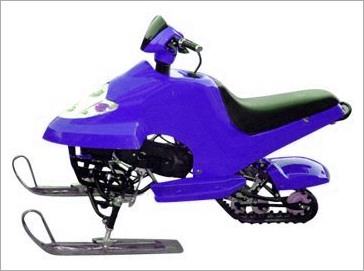Winterize your Scooter
What to do to before storing your scooter for the winter
Not all of us live in areas with a climate that allows for safe year-round riding. It's no fun (and it's not safe) to ride in ice and snow, and it's not very pleasant riding when the temperature is below freezing, even with warm clothing. Many scooter and motorcycle riders store their bikes over the Winter, then bring them back out in the Spring when the weather has improved.

Unless your scooter looks like this, you might not want to ride it in the snow!
So what do you need to do if you don't ride for 3 months? Well, the last thing you want to do is leave the scooter outside without any preparation. Ideally you'd store it in a shed or garage where it's protected from the weather. But is that all? The answer is no. There are several things you can do which will make it much easier to get the scooter back on the road and running well in the Spring.
Gas doesn't like being stored for long periods of time. The gas in the carburetor can evaporate leaving deposits behind which can gum up the operation. Ideally you should drain the gas from the tank AND from the carburetor. Most carburetors have a method to drain the gas from the bowl. At the very least you can drain the tank, then run the engine until it uses up the gas in the carburetor. There may still be some gas in the float bowl though, so drain the bowl if you can. Use the gas in your car so it doesn't go stale. If you want to store it for some reason, make sure you add a small quantity of fuel stabilizer (such as STA-BIL) to it.
Some people suggest leaving the tank full of gas (with fuel stabilizer added) so that you don't get any rusting from condensation. If you take that route you should add stabilizer to the fuel then ride for a few miles to get the stabilized fuel to the carburetor. You still probably want to drain the gas out of the carburetor and float bowl though before prolonged storage.
Bring the battery indoors. They don't like cold or standing without use and 3 months outdoors in freezing temperature will likely kill it. Ideally you should attach the battery to a float charger. This keeps the voltage up without putting a lot of current through the battery. A good charger (like the Deltran shown on the left) will sense the battery charge and reduce the voltage when it's fully charged. The Deltran Battery Tender Junior is a 4 stage battery charger/maintainer that can be used on most small lead acid batteries such as those found on scooters and motorcycles. It uses micro-processor technology to charge and maintain the battery so it will be ready when you are ready to use your scooter again.
Make sure the scooter is properly tuned and running well before you store it. If it's hard to start and doesn't run well before you store it for a few months over the Winter, it's going to be even harder to get it running again in the Spring. It's better to do a tune up before you store it.
Do an oil change BEFORE you store the scooter. Oil picks up all sorts of corrosive contamination and leaving the engine cold and sitting in old oil isn't a good idea. You could just drain the oil, but it's safer to change it in case you forget to replace it in the spring!
Some people like to remove the spark plug, put a small volume of oil into the cylinder, turn the engine over a few times with the kick start, then replace the plug. The idea is that the oil will coat the cylinder walls and prevent any rusting if moisture gets in there. This is a good idea if your winters are long (5-6 months), but probably isn't needed if the scooter will only be inoperative for 2-3 months.
If you can jack up the scooter so it's not putting its full weight on the tires, that's worth doing too to avoid "flat spotting". Just using the center stand might be enough. You might want to check the tire pressures over winter too and keep them properly inflated.
Clean the scooter. Don't leave corrosive deposits to do their worst over the winter. Clean off all the dirt and lubricate things like the brake linkages and throttle cable.
Cover the scooter with some sort of breathable cover. You don't want to cover it with plastic which allows condensation. Indoors you can use any sort of fabric. Outdoors you'd want to get a cover designed for scooters or motorcycles which allows condensation to evaporate.
If you have a scooter with a water cooled engine, make sure that you have enough anti-freeze in the cooling system to prevent freezing on the coldest days.
Plug the exhaust pipe. Mice like to look for places to live in the winter too!
It's not a good idea to just store the scooter and simply run the engine for short periods of time over the winter because if you don't get everything hot enough, this may add moisture to the engine, exhaust etc., which can then cause corrosion. If you could take it out for a 10 mile run once a week over the winter, you'd probably be OK (as long as you added stabilizer to the gas), but starting it up in the garage for a few minutes may do more harm than good.
Additional Resources